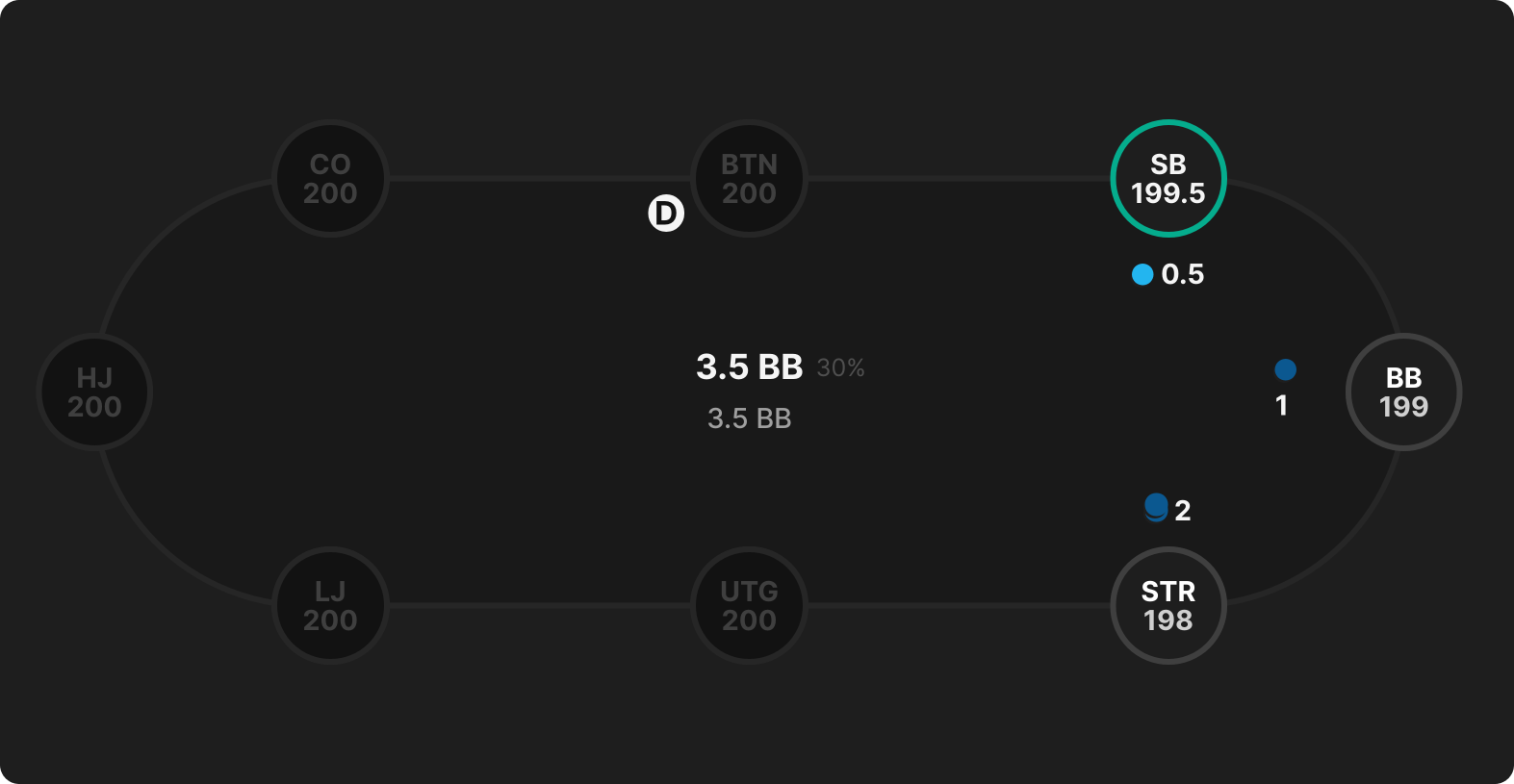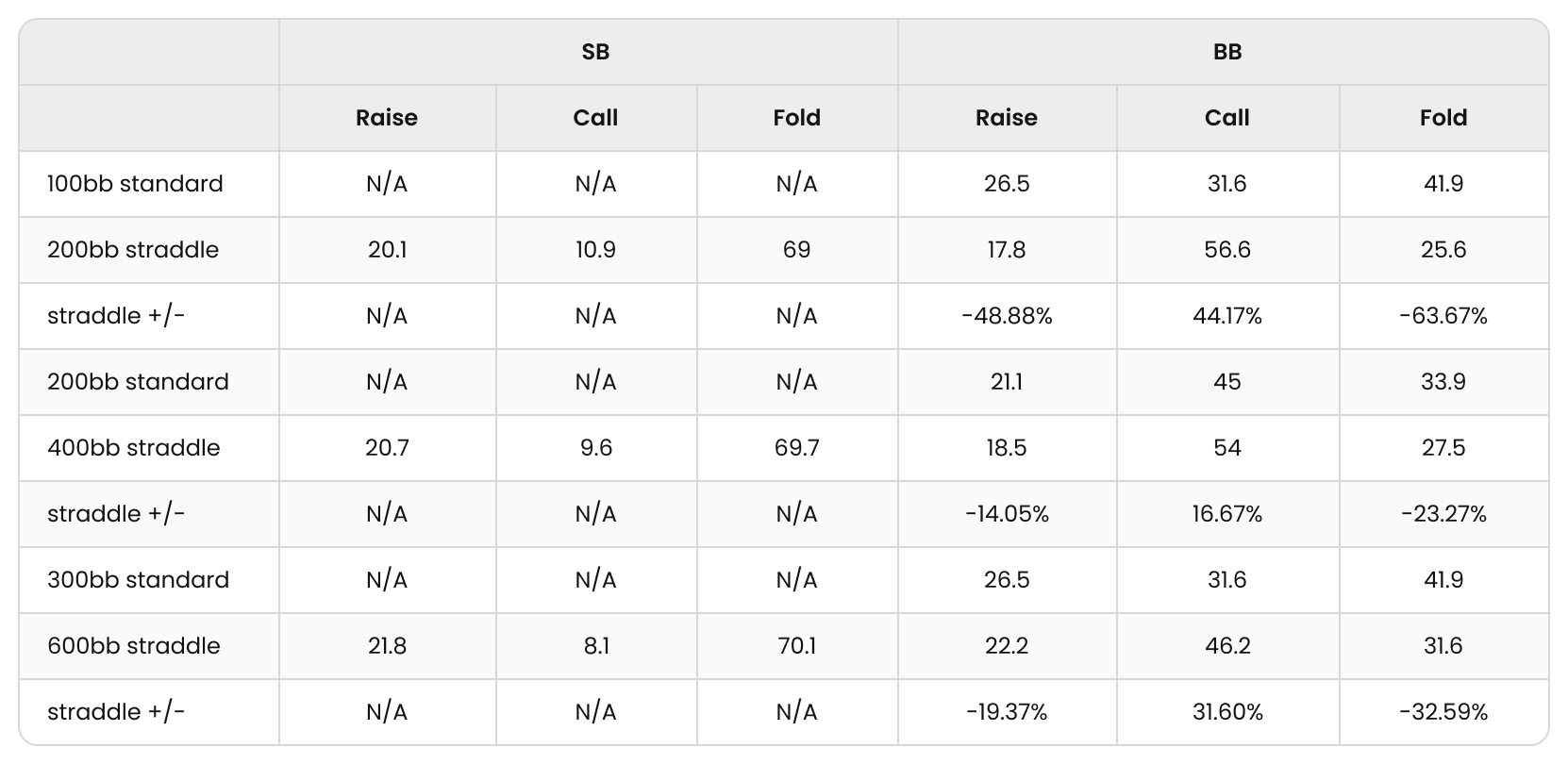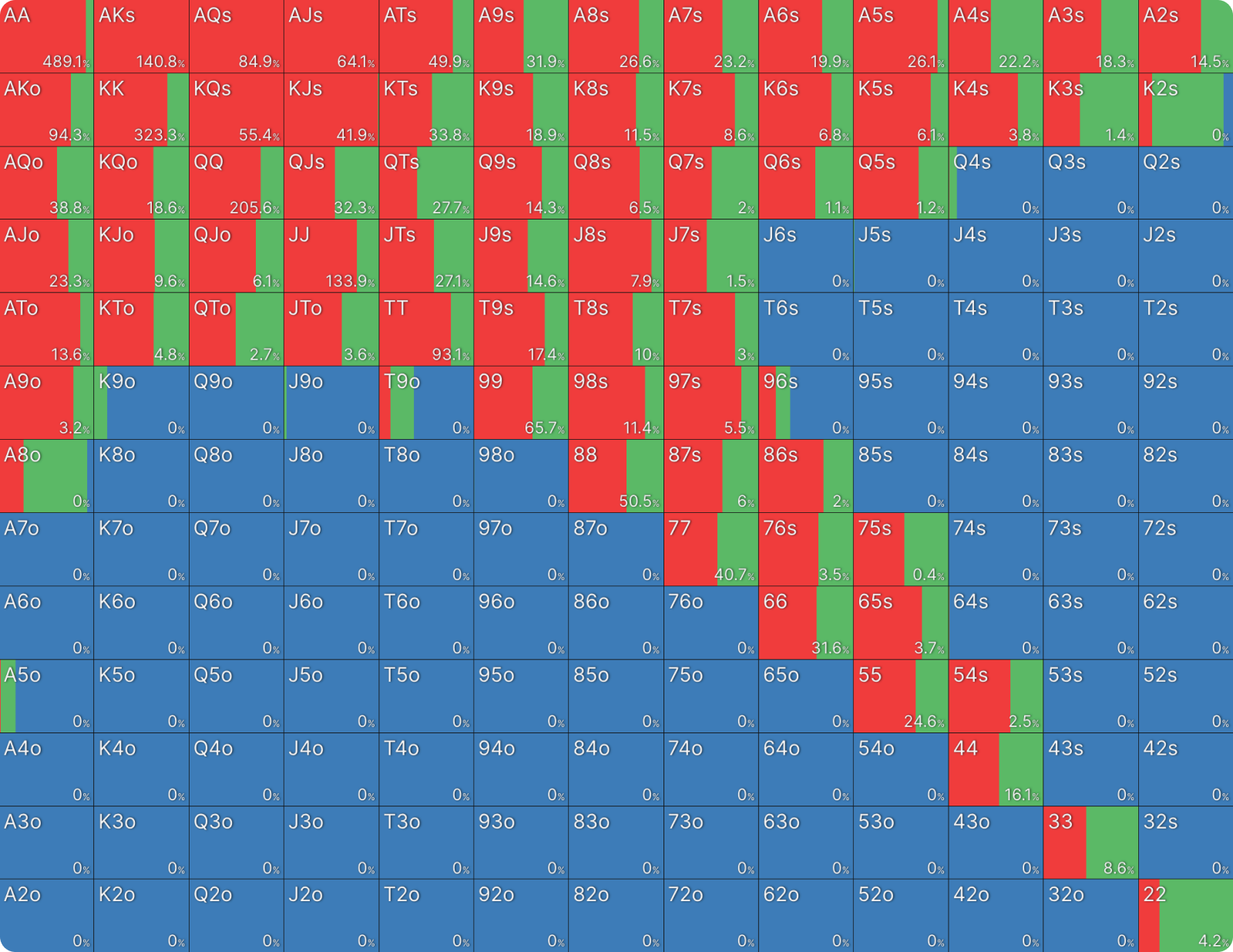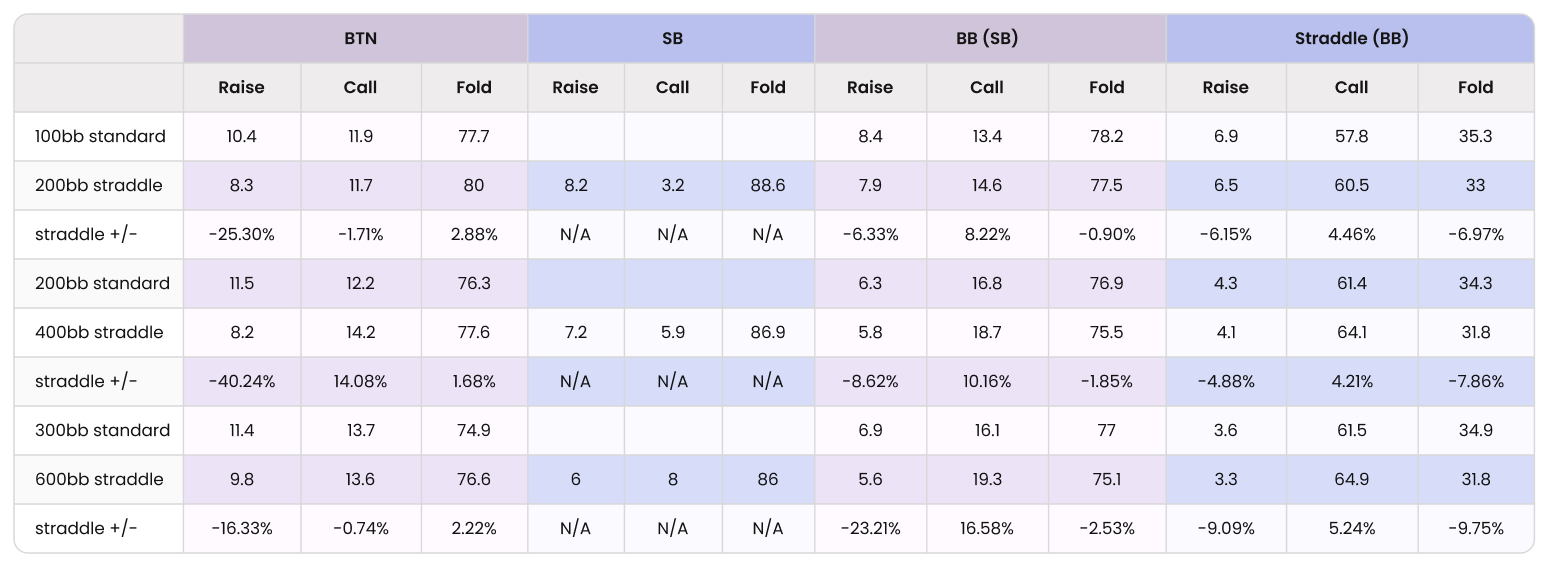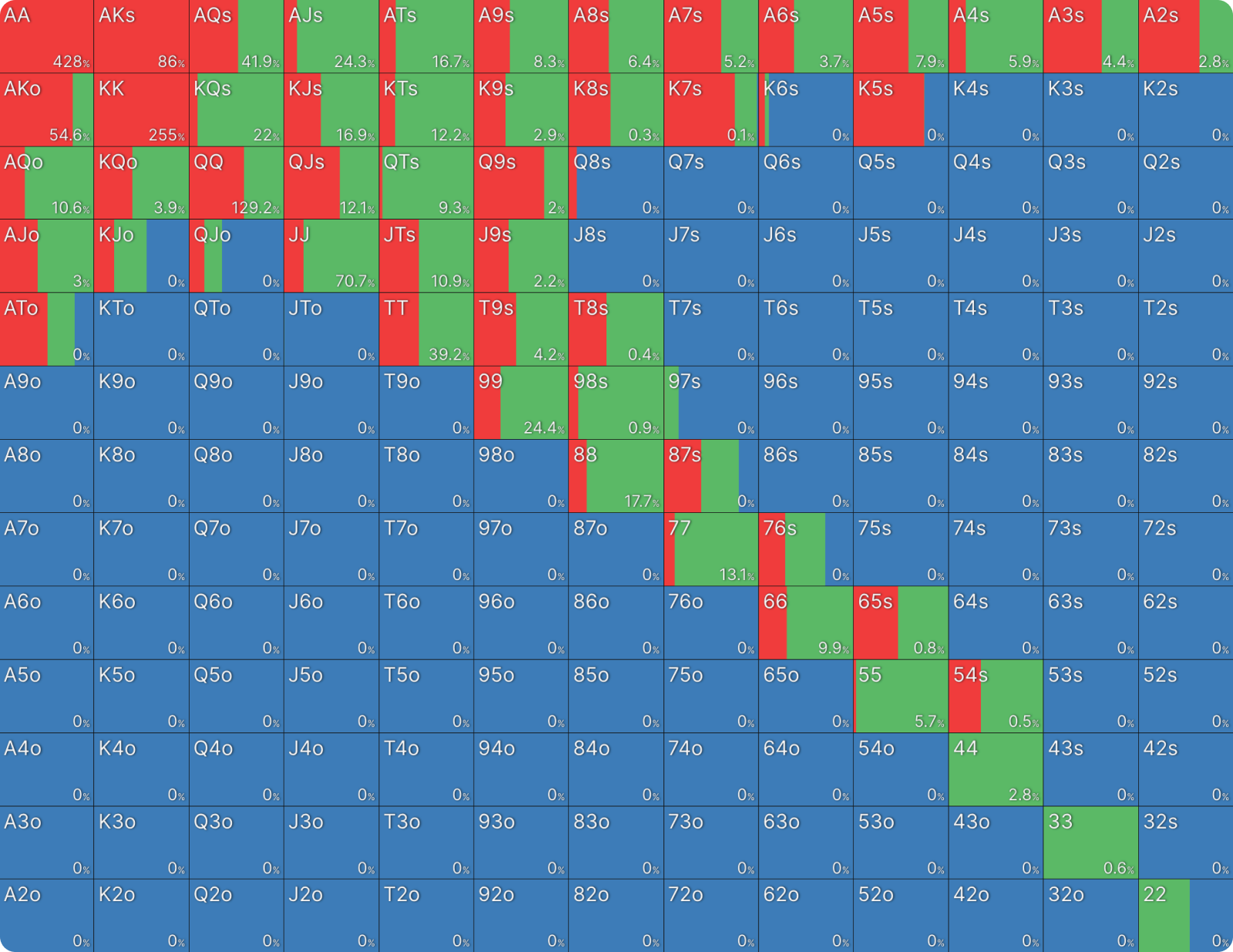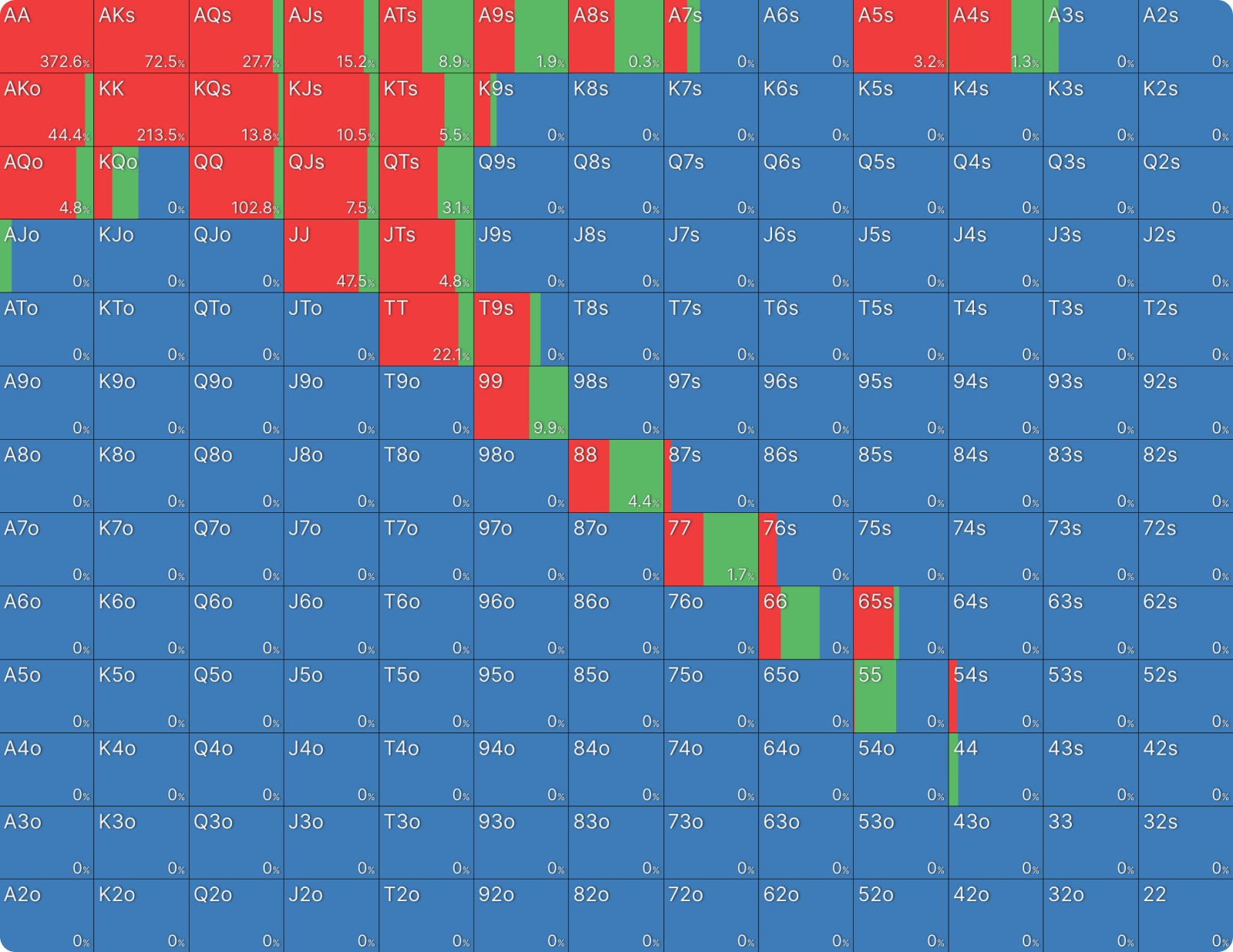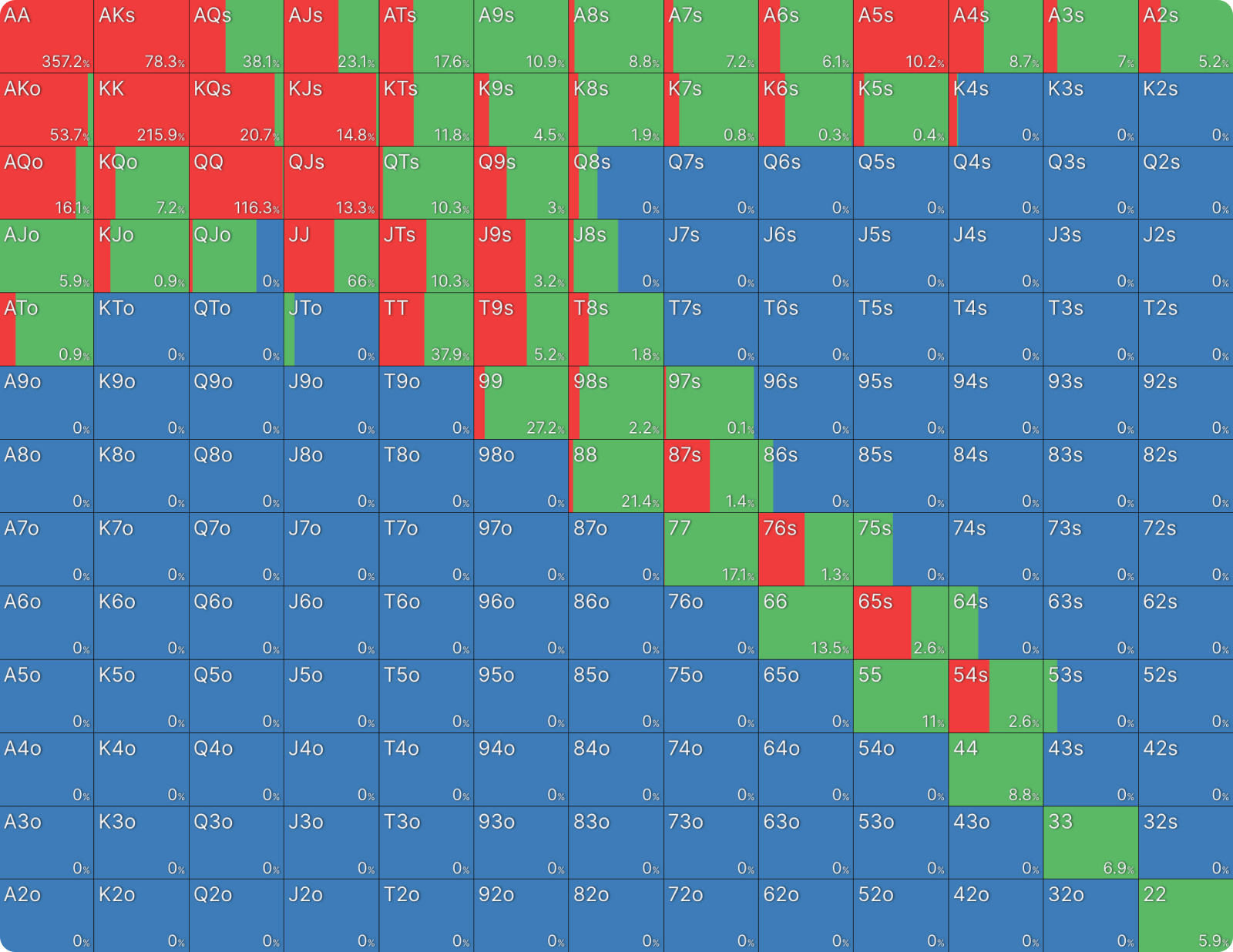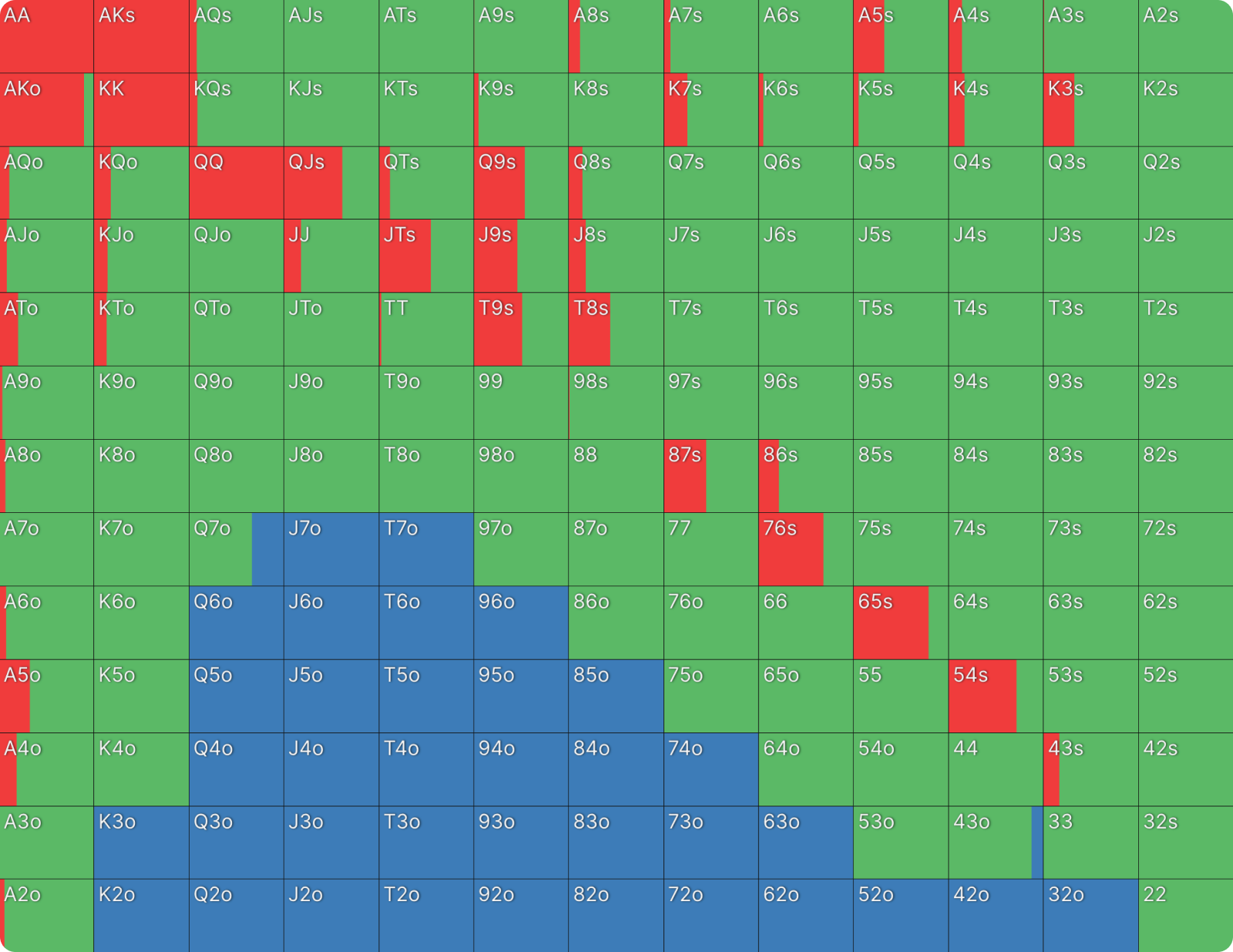w
Preflop Strategy in Straddled Pots
Many games allow “straddles,” where a player who is not in the Blinds voluntarily posts a blind bet that functions just like a blind: it is live, and if no one else raises, the straddling player still has the opportunity to raise before the flop is dealt. Straddles are typically twice the big blind, though larger is sometimes permitted.
UTG is the most common position for a straddle, which buys the straddling player the right to act last (preflop) after everyone else, including the blinds. Straddles are sometimes allowed on the BTN or in other seats as well, with varying rules about how action proceeds around the table. This article will deal only with UTG straddles to 2bb, though the principles discussed here should help you adapt to other types of straddles as well.
Straddles are a staple of live poker. Some games are played with a mandatory straddle, some with a “mandatory” straddle (one that’s informally enforced only by social pressure and general agreement among the players), and sometimes someone is simply in the mood to gamble and throws out a straddle voluntarily, with no expectation that anyone else follows suit. Thus, regardless of whether you ever straddle yourself, it behooves you to understand how straddles change the nature of the game and affect your incentives from any seat at the table.
Should You Straddle?
Short answer: No.
Putting money into the pot without looking at your cards is a massive disadvantage.
Not even the best players in the world turn a profit from the blinds. Straddling the Button is, naturally, less expensive than straddling in early position, but it is still almost always a money-losing proposition. You can construct hypotheticals where it is profitable, but the fact remains it is almost always a bad idea if your primary objective at the poker table is to be a winning player.
The longer answer is that there may be social/political reasons for straddling.
If the entire table agrees to straddle, then you are effectively raising the stakes (often without raising the rake) without taking on any disadvantage relative to your competition.
This will generally be to your advantage if you are among the best players at the table. As we will discuss below, however, you should be aware that straddling does dramatically reduce the effective stack size, which may reduce your edge and win rate. The higher stakes usually compensate for that, and in some cases, such as if stacks are extremely deep, reducing the effective stack size may not even make much difference to how the game plays.
If you are playing in a private or invite-only game where giving action is important, it may be a good idea to straddle from time to time as a gesture of goodwill toward the more gamble-oriented players.
Even though this is -EV in a vacuum, straddling can be a wise long-term investment in keeping your seat in a good game.
Note that this only applies to games where you can literally get uninvited if you are perceived as a nit. Straddling solely for the sake of creating a loose or gambley image is generally not advisable.
Straddles and Pot Size
We tend to measure stack size before the flop in big blinds, but this can be misleading in straddled pots. In a $5/$10 game with a $20 straddle, the big(gest) blind is effectively $20, and a $1000 stack would be better thought of as a 50bb stack rather than a 100bb stack. This means what would’ve felt like a large bet before the straddle was in play, will now be commonplace. Consequently, many hands that were not previously worth your entire stack will be in a straddled game.
Even that is not perfect, however, because the straddle actually more than doubles the preflop pot size. The late Paul Magriel coined the unit M to measure stacks as a function of the starting pot. In a standard $5/$10 game, there is $15 in the pot, so a stack of $15 would be 1M and a $1000 stack would be 66.67M.
With a straddle on, the starting pot would be $35 and a $1000 stack would be 28.57M, a good deal less than half what it was before the straddle. This affects things like:
- How often you will play for larger pots.
You will routinely win and lose much larger pots than in a standard game. - How big your bankroll should be (if you are playing in a game that regularly features straddles).
Your bankroll requirements will be roughly twice what they would be without the straddle.
Opening Strategy
A preflop open-raise, like any other play in a poker game, is a wager carrying both risks and rewards. This depends a bit on your hand, but broadly speaking, the reward is the money in the pot and the risk is determined by the amount you raise and the number of players remaining to act behind you.
Straddles complicate this calculation in multiple ways. On the one hand, they more than double the size of the starting pot, from 1.5bb to 3.5bb (or more, in games where straddles of more than twice the big blind are permitted). On the other hand, they increase the number of players remaining to act when you are in the best stealing positions. Raising the Button offers a greater reward, with an extra straddle to be won, but also a greater risk, with three players behind you rather than two.
Frequency Comparison
The chart below shows Raise First In (RFI) frequencies for all seats “in the field” (i.e., not in the blinds/straddle). For the sake of clarity, all seats are designated relative to the BTN rather than the BB. Thus, UTG in a standard 8-handed game is BTN-5. In an 8-handed straddle game, BTN-5 is the Straddle and so is not included in this chart; we will discuss playing from the Straddle later.
This chart compares frequencies between a standard game and a straddle game with twice as many big blinds (i.e., an equivalent number of straddles). Bear in mind the caveat above that this is not a perfect comparison, as stacks in a 200bb straddle game are slightly shallower than those in a 100bb standard game.
The patterns here are complex, and we’ll examine them in a bit more detail in a moment, but let’s start with the key takeaway, which is relatively clear:
Straddles almost always make open-raising less appealing compared to the same position (relative to the Button) in a standard game.
The only exception is the very earliest seat or two (depending on stack depth), where one more player behind doesn’t make much difference but an extra two big blinds in the pot does.
BTN
Opening the Button in a straddled pot means opening into 150% more players than in a standard pot. It’s not quite 150% worse because after you put in a raise, the SB and BB will be more constrained in playing back at you than in a standard game, but this is fundamentally why the BTN in these straddled pot sims opens 15–20% less frequently than in the standard sims.
BTN-4
When you are BTN-4 (UTG in a straddled pot), you’re raising into only 117% more players. The four who have position on you are a bigger concern than the three who don’t, and that number (of IP opponents) doesn’t change in a straddled pot. This is why you can raise as much or more from early position when the straddle is on, especially with deeper stacks. The main outcome that occurs more frequently as a result of the straddle is the one where you get to play postflop heads up in position, and the deeper you are, the better that outcome gets.
To better understand what’s going on here, let’s double-click on all the different scenarios that could happen after you open-raise:
- Take it down – For all but your strongest hands, this is the best outcome. It’s less likely to happen in a straddled pot, but it’s worth more when it does happen.
- Called by an OOP opponent – This is usually the next best thing to taking it down immediately. You’ll have to fight for the pot after the flop, but at least you get to do so with the advantage of position. This outcome is more likely in a straddled pot both because there are more players behind the Button and because the Straddle will be getting an extremely good price to call if no one else does.
- Called by an IP opponent – This is usually a bad outcome, especially with deeper stacks. Just as with your initial raise, the straddle increases both the risk and reward of these calls. The IP opponent is getting better odds, but they also take on more risk with an additional player behind.
- Raised by an OOP opponent – Raises are typically worse than calls, as your weakest hands won’t even get to see a flop. Just as with OOP calls, OOP raises are more likely with three players behind the Button. Deeper stacks make OOP 3-bets less likely and less costly to you, as you’ll have an easier time flatting or 4-betting with more money behind.
- Raised by an IP opponent – This is usually a disaster, and it only gets worse and more likely as stacks get deeper. At equilibrium, a straddle makes such raises less likely, as the 3-bettor takes on greater risk of a 4-bet from having more players behind them.
- Other – There are other outcomes, such as getting called by multiple opponents or getting cold 4-bet, but they are less likely, and they all start with one of the actions above, so we will not consider them further here. Suffice to say that getting called by two players is worse than getting called by one and also more likely in a straddled pot, getting cold 4-bet is worse than getting 3-bet and more likely in a straddled pot, etc.
Opening From the Blinds
Comparisons get even more tricky here because the SB in a straddled pot really has no equivalent in a standard pot. The BB in a straddled pot is the most similar position to the SB in a standard pot: both have half the chips needed for a call already committed to the pot and just one player left to act after them. However, BB is getting a better price to call the straddle than SB gets to limp in a standard pot, so their strategies still differ.
The SB in a straddled pot faces a nasty dilemma. They have some live money in the pot, but they are out of position to two opponents, both of whom have even more live money in the pot, and so are strongly incentivized to contest their raises. It is a testament to the power of position that in a 100bb standard pot, BTN open-raises into two OOP opponents with 44.2% of hands, but in a straddled pot, SB raises into two IP opponents with just 20% of hands and calls another 10%. Entering the pot only gets less desirable as stacks grow deeper.
Besides, this strategy is difficult to implement with most hands mixing when they enter the pot at all:
If SB folds, BB plays an even looser strategy than SB would in a standard game, as they are getting better odds to contest the pot.
Responding to an Open
Just as the BB in a straddled pot is comparable to the SB in a standard pot, the Straddle is comparable to the BB in a standard pot, with the important difference that they are getting even better odds on a call.
Let’s see how this affects their response to a CO open-raise:
Comparing BTN Responses
Facing an open-raise, BTN folds more and 3-bets less in straddled pots. As we discussed above, this is a result of having three rather than two players still holding cards behind them. Although they sometimes call hands as strong as QQ and AKo with 200bb stacks, these hands never 4-bet a squeeze from the blinds if CO folds. If CO calls the squeeze, then these hands 4-bet.
With deeper stacks, BTN sometimes calls CO’s raise with KK as well, but not even this hand 4-bets a squeeze if CO folds! It seems the rest of BTN’s calling range is weak enough so that these hands have very good implied odds when calling.
Comparing SB Responses
The SB, with so little invested and such bad position, has little incentive to enter the (single-raised) pot. Because they play only very strong hands in the first place, they usually enter with a raise if they enter at all. Technically, they do have a calling range, but it is not especially important to their strategy. Even with 200bb stacks, they have no pure calls. Every candidate is either weak enough to consider folding or strong enough to consider raising:
Straddle BB Compared to Standard SB Response
For the BB, it’s a different story. They are getting better odds on a call than SB would in a standard pot (thanks to the 0.5bb in dead money after SB folds) and have a substantial calling range that only gets wider as stacks get deeper:
STR Compared to Standard BB Response
The most dramatic comparison is between the Straddle and the standard BB. When the Straddle faces a min-raise, they are getting odds of nearly 4:1. Specifically, they need to realize just 21% equity to make calling profitable, as opposed to the 28.6% BB needs in a standard pot. This makes both folding and raising less appealing by comparison, resulting in an extremely high calling frequency.
Conclusion
Straddles change the game for all players, not just the one who straddled. They dramatically decrease the stack-to-pot ratio and increase both the risk and reward of contesting pots (with the bigger reward being the reason why gamblers enjoy them so much).
It is a very good thing for you when your opponents put money into the pot blind, but you do need to adjust to it. With an extra player behind the BTN, you should mainly play tighter with both your opening raises and your responses to raises relative to your usual strategy in a given seat.
Above all, bear in mind that because stacks are shallower, what would have been a large bet or raise in a standard pot will be par for the course in a straddled pot. Many more hands will be worth your entire stack, both before and after the flop. If you don’t have the bankroll or the stomach for that, consider changing games if straddling is routine.
Author
Andrew Brokos
Andrew Brokos has been a professional poker player, coach, and author for over 15 years. He co-hosts the Thinking Poker Podcast and is the author of the Play Optimal Poker books, among others.
Wizards, you don’t want to miss out on ‘Daily Dose of GTO,’ it’s the most valuable freeroll of the year!
We Are Hiring
We are looking for remarkable individuals to join us in our quest to build the next-generation poker training ecosystem. If you are passionate, dedicated, and driven to excel, we want to hear from you. Join us in redefining how poker is being studied.



